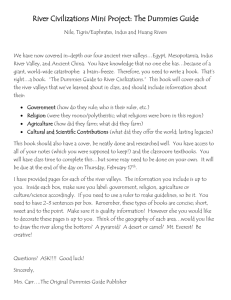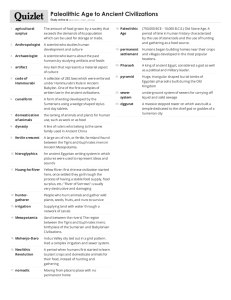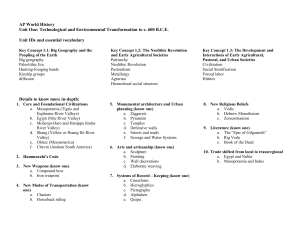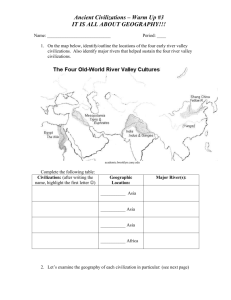The Four Ancient River Valley Cultures
advertisement
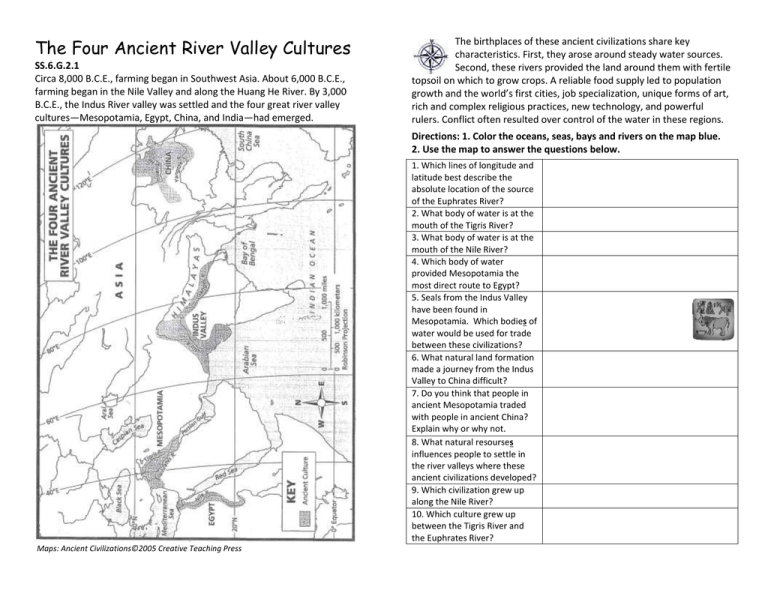
The Four Ancient River Valley Cultures SS.6.G.2.1 Circa 8,000 B.C.E., farming began in Southwest Asia. About 6,000 B.C.E., farming began in the Nile Valley and along the Huang He River. By 3,000 B.C.E., the Indus River valley was settled and the four great river valley cultures—Mesopotamia, Egypt, China, and India—had emerged. The birthplaces of these ancient civilizations share key characteristics. First, they arose around steady water sources. Second, these rivers provided the land around them with fertile topsoil on which to grow crops. A reliable food supply led to population growth and the world’s first cities, job specialization, unique forms of art, rich and complex religious practices, new technology, and powerful rulers. Conflict often resulted over control of the water in these regions. Directions: 1. Color the oceans, seas, bays and rivers on the map blue. 2. Use the map to answer the questions below. 1. Which lines of longitude and latitude best describe the absolute location of the source of the Euphrates River? 2. What body of water is at the mouth of the Tigris River? 3. What body of water is at the mouth of the Nile River? 4. Which body of water provided Mesopotamia the most direct route to Egypt? 5. Seals from the Indus Valley have been found in Mesopotamia. Which bodies of water would be used for trade between these civilizations? 6. What natural land formation made a journey from the Indus Valley to China difficult? 7. Do you think that people in ancient Mesopotamia traded with people in ancient China? Explain why or why not. 8. What natural resourses influences people to settle in the river valleys where these ancient civilizations developed? 9. Which civilization grew up along the Nile River? 10. Which culture grew up between the Tigris River and the Euphrates River? Maps: Ancient Civilizations©2005 Creative Teaching Press The birthplaces of these ancient civilizations share key characteristics. First, they arose around steady water sources. Second, these rivers provided the land around them with fertile topsoil on which to grow crops. A reliable food supply led to population growth and the world’s first cities, job specialization, unique forms of art, rich and complex religious practices, new technology, and powerful rulers. Conflict often resulted over control of the water in these regions. The birthplaces of these ancient civilizations share key characteristics. First, they arose around steady water sources. Second, these rivers provided the land around them with fertile topsoil on which to grow crops. A reliable food supply led to population growth and the world’s first cities, job specialization, unique forms of art, rich and complex religious practices, new technology, and powerful rulers. Conflict often resulted over control of the water in these regions. Directions: 1. Color the oceans, seas, bays and rivers on the map blue. 2. Use the map to answer the questions below. Directions: 1. Color the oceans, seas, bays and rivers on the map blue. 2. Use the map to answer the questions below. 1. Which lines of longitude and latitude best describe the absolute location of the source of the Euphrates River? 2. What body of water is at the mouth of the Tigris River? 3. What body of water is at the mouth of the Nile River? 4. Which body of water provided Mesopotamia the most direct route to Egypt? 5. Seals from the Indus Valley have been found in Mesopotamia. Which bodies of water would be used for trade between these civilizations? 6. What natural land formation made a journey from the Indus Valley to China difficult? 7. Do you think that people in ancient Mesopotamia traded with people in ancient China? Explain why or why not. 8. What natural resourses influences people to settle in the river valleys where these ancient civilizations developed? 9. Which civilization grew up along the Nile River? 10. Which culture grew up between the Tigris River and the Euphrates River? 1. Which lines of longitude and latitude best describe the absolute location of the source of the Euphrates River? 2. What body of water is at the mouth of the Tigris River? 3. What body of water is at the mouth of the Nile River? 4. Which body of water provided Mesopotamia the most direct route to Egypt? 5. Seals from the Indus Valley have been found in Mesopotamia. Which bodies of water would be used for trade between these civilizations? 6. What natural land formation made a journey from the Indus Valley to China difficult? 7. Do you think that people in ancient Mesopotamia traded with people in ancient China? Explain why or why not. 8. What natural resourses influences people to settle in the river valleys where these ancient civilizations developed? 9. Which civilization grew up along the Nile River? 10. Which culture grew up between the Tigris River and the Euphrates River?
